The Monstera Standleyana, also known as the Five Holes Plant, is a stunning tropical plant that is native to the rainforests of Nicaragua, Honduras, and Panama. Although it's called the Five Holes plant it doesn't develop fenestrations or holes in its leaves, its beautiful, variegated leaves with white or yellow patches more than make up for it.
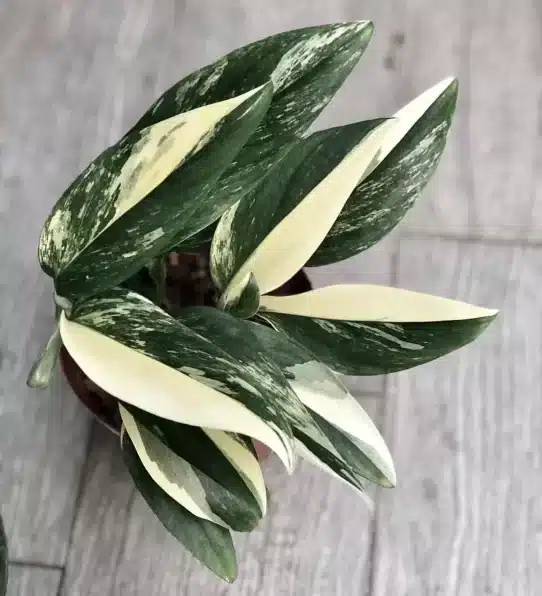
This plant can grow up to several feet tall and equally as wide, making it an ideal choice for larger spaces or as a statement piece in a room. In addition to its aesthetic appeal, the Monstera Standleyana is relatively low maintenance, making it a popular choice for plant enthusiasts of all levels.
In this guide, we will cover everything you need to know about caring for your Monstera Standleyana, including its light, water, temperature, and humidity needs, as well as fertilization, propagation, pruning, and common problems to look out for.
All About Monstera Standleyana
Monstera Standleyana, also known as Philodendron Cobra, is a strikingly unique plant that belongs to the Araceae family. It is native to the tropical rainforests of Central and South America, including Nicaragua, Honduras, Panama, and Costa Rica.
The Monstera Standleyana plant is a vine-like species with glossy, lance-shaped leaves that can grow up to 9 inches in length and 5 inches in width. Unlike other Monstera species, the Standleyana does not develop the characteristic fenestrations or holes in its leaves, but it makes up for this with its stunning variegation. The leaves of this plant are variegated with yellow, white, or cream-colored patches that make it a popular choice among plant enthusiasts.
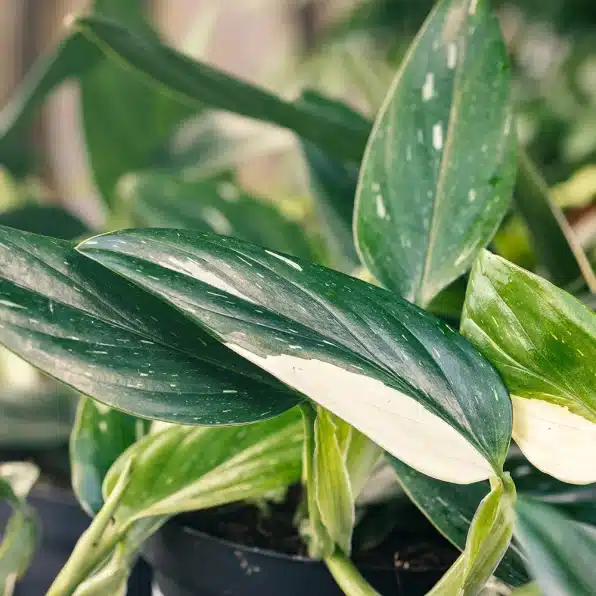
In nature, Standleyana can grow up to 20 feet but for the average house plant this might be a bit much, but it can be manageable and kept at a size under 5 ft. A relatively easy plant to care for this Monstera prefers bright, indirect light, well-draining soil, and moderate humidity and it really doesn't like to be over-watered.
Monstera Standleyana is a stunning and unique plant that can add a touch of tropical elegance to any space. Its variegation and glossy leaves make it a popular choice for indoor gardening, and its climbing nature can create a beautiful green display when trained to grow up a trellis or moss pole.
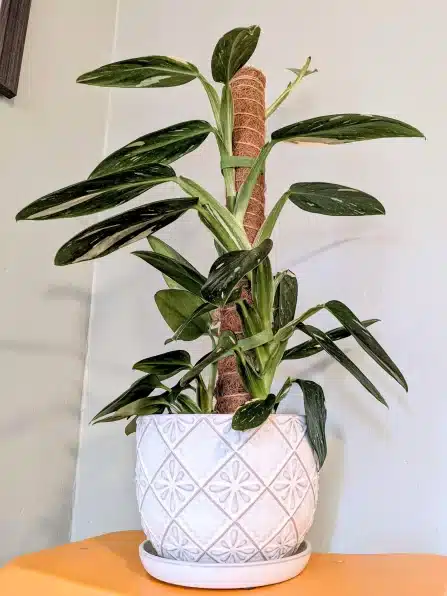
Monstera Standleyana Plant Basics:
| Common Name: | Five Holes plant, Philodendron Standleyana, Philodendren Cobra |
| Botanical Name: | Monstera Standleyana, Monstera standleyana albo variegata |
| Plant Type: | Tropical, evergreen |
| Size: | 2-5 feet indoors, leaves 5 x 9 inches |
| Light: | Bright, indirect light |
| Soil: | Light, well-draining soil |
| Water: | Water regularly but allow to dry between waterings |
| Vulnerabilities: | Overwatering, mealybugs, spider mites, and thrips. |
| USDA Growing Zones: | 10 – 12 |
Monstera Standleyana Plant Care Guide
Adaptable, and easy to care for Monstera Standleyana is a good choice for a house plant, but in order to get your plant to thrive and grow you will need to follow a few guidelines. In this section, we'll cover everything you need to know to keep your plant healthy and happy, including watering, lighting, fertilizing, and more.
Type of Soil for Monstera Standleyana
The basic soil needs of Monstera Stanleyana are simply a good well-draining potting soil. Better quality means a healthier plant and amendments mean that your plant has the greatest potential for surviving and thriving.
Here are some tips for choosing and preparing soil for your Monstera Standleyana:
- Use a high-quality potting mix: Choose a potting mix that is specifically formulated for indoor plants and contains a blend of peat moss, perlite, and vermiculite. This type of soil provides good drainage and aeration while retaining enough moisture to keep your plant healthy.
- Avoid heavy or compacted soils: Heavy or compacted soils can restrict root growth and prevent your plant from getting the oxygen it needs. Choose a light, airy soil that allows water to drain freely.
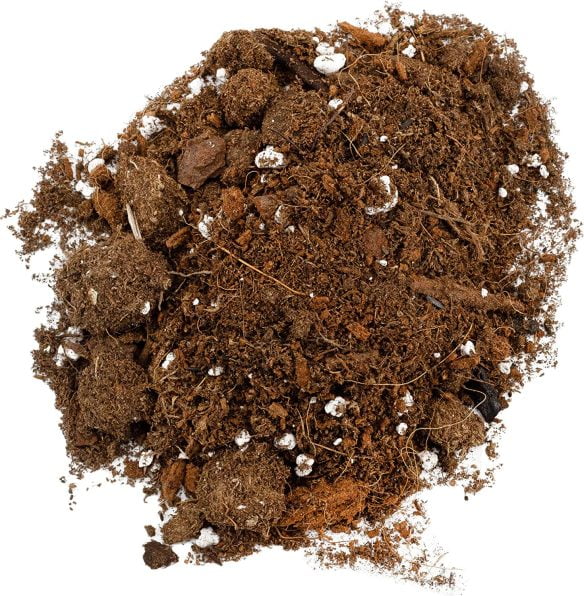
- Consider adding perlite: Perlite is a lightweight, volcanic rock that can be added to your potting mix to improve drainage and aeration. It also helps to prevent soil compaction over time.
The key to choosing the right soil for your Monstera Standleyana is to provide a well-draining, nutrient-rich potting mix that promotes healthy root growth and provides your plant with the support it needs to thrive.
What Are the Watering Needs of Monstera Plant?
The Monstera Standleyana plant prefers to be kept moist but not overly wet. Overwatering can lead to root rot and other issues, so it's important to let the top layer of soil dry out slightly between waterings.
Here are some tips for watering your Monstera Standleyana:
- Check the soil moisture: Check the soil with your finger about an inch deep to check for moisture. If the soil feels dry, it's time to water your plant.
- Water thoroughly: When you water your plant, be sure to water it thoroughly. Use a pot that has holes in the bottom and run water through the soil. This will also flush out salt and minerals that may have built up in the soil.
- Adjust the watering frequency based on the environment: The frequency of watering will depend on the temperature, humidity, and light levels. A warmer and drier environment means you may need to water more often.
- Avoid getting water on the leaves: When watering your Monstera Standleyana, be careful to avoid getting water on the leaves, as this can lead to leaf spot and other issues.
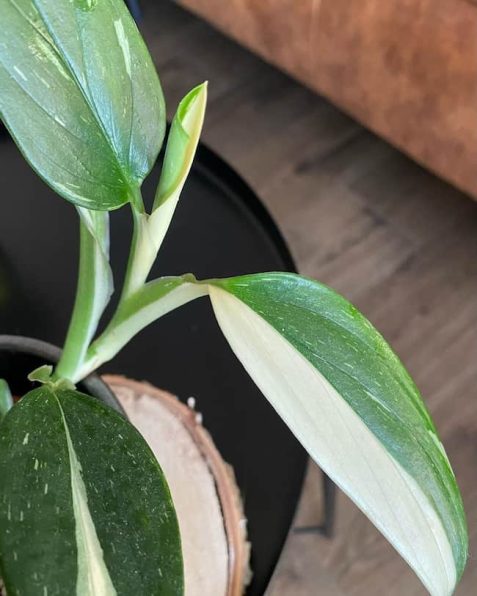
How Much Light the Standleyana Needs?
Monstera Standleyana plants prefer bright, indirect light but can also tolerate lower light conditions.
Here are some tips:
- Bright, indirect light: Place it near a window where it can receive filtered sunlight or in a room with bright, indirect light.
- Avoid direct sunlight: Direct sunlight can cause the leaves to burn
- Low-light conditions: Monstera Standleyana plants can tolerate lower light conditions, but they may grow slower and produce smaller leaves.
- If your plant is not getting enough light, you may notice the leaves turning yellow or the plant becoming leggy.
- Artificial light: If you don't have access to bright, indirect light, you can use artificial light to supplement your Monstera Standleyana's lighting needs.
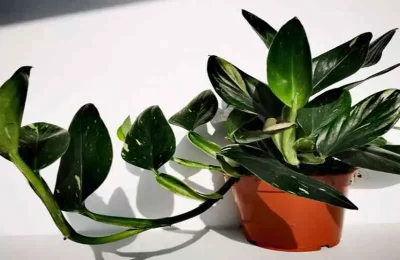
Keeping an eye on your plant will give you a heads up if the light needs are off. Your plant will begin to send runners out to find a brighter light. If your Standleyana is getting leggy it probably needs more light.
Temperature & Humidity Needs
Monstera Standleyana plants prefer warm and humid environments, but they can tolerate a range of temperatures and humidity levels.
Here are some tips for providing the right temperature and humidity for your Monstera Standleyana:
Temperature: Monstera Standleyana plants prefer temperatures between 60-80°F (15-27°C). Avoid exposing them to temperatures below 55°F (13°C) or above 90°F (32°C), as extreme temperatures can cause damage to the plant.
Humidity: Monstera Standleyana plants prefer high humidity levels between 60-80%. If the air in your home is dry, you can increase humidity levels by using a humidifier, or placing a tray of water near your plant. Setting your pot on a bed of moist gravel can also be a way to increase humidity level for your plant.
Avoid dry air: These plants can be sensitive to dry air, avoid placing them in areas where dry blowing air can potentially cause the leaves to brown and curl. Avoid placing your plant near drafts, heating vents, or air conditioning units, as these can dry out the air and damage the plant.

Fertilizing the Monstera Standlyeyana
As with most house plants the Standleyana can benefit from regular fertilizing, which helps to promote growth as well as healthy foliage.
Here are some fertilizing tips:
- Use a balanced fertilizer: Use a balanced fertilizer with equal amounts of nitrogen, phosphorus, and potassium, such as a 10-10-10 or 20-20-20 fertilizer. Diluting the mixture is a good idea. Make sure the soil is wet before applying the fertilizer even if you are using a liquid type. You can also find fertilizers that are specifically made for Monsteras with a 5-2-3 NPK ratio.
- Fertilize during the growing season: Fertilize during the growing season, which is typically spring and summer. Reduce or stop fertilizing during the fall and winter when the plant is dormant. Adding fertilizer during its dormant season can be harmful to your plant, and doesn't really help it.
- Apply fertilizer regularly: Apply the diluted fertilizer to the soil every 2-4 weeks during the plant's growing season. This is generally spring and summer respectively. Often the cycle recommended is 3 times per year.
Pruning the Monstera Plant
Prune your Monstera Standleyana during the growing season, which is typically spring and summer. This is when the plant is actively growing and can recover quickly from pruning.
- Use clean, sharp tools: Use clean, sharp pruning shears or scissors to make clean cuts and prevent the spread of disease.
- Remove dead or damaged leaves: Remove any dead or damaged leaves by cutting them off at the base of the stem. This can help prevent the spread of disease and make room for new growth.
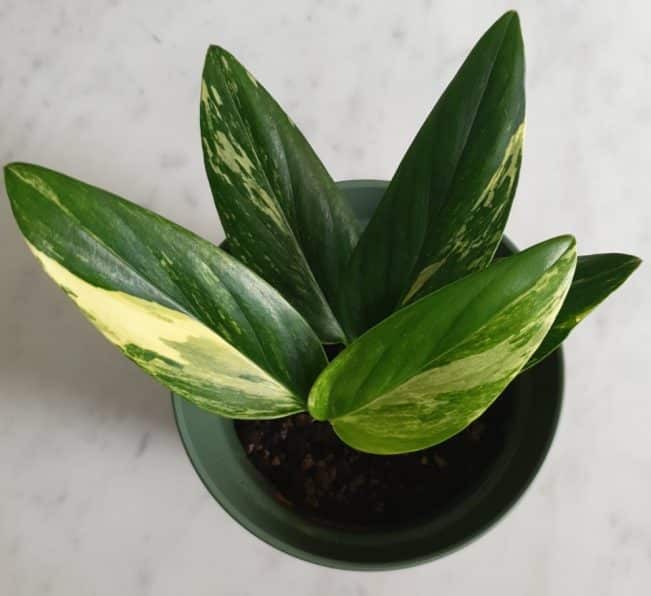
- Trim back leggy stems: If your Monstera Standleyana is getting too leggy or sparse, you can trim back the stems to encourage new growth. Cut back the stem to just above a leaf node to promote new growth from that point.
How to Propagate Monstera Standleyana
Monstera Standleyana plants can be propagated through stem cuttings. Here are some steps to propagate your Monstera Standleyana:
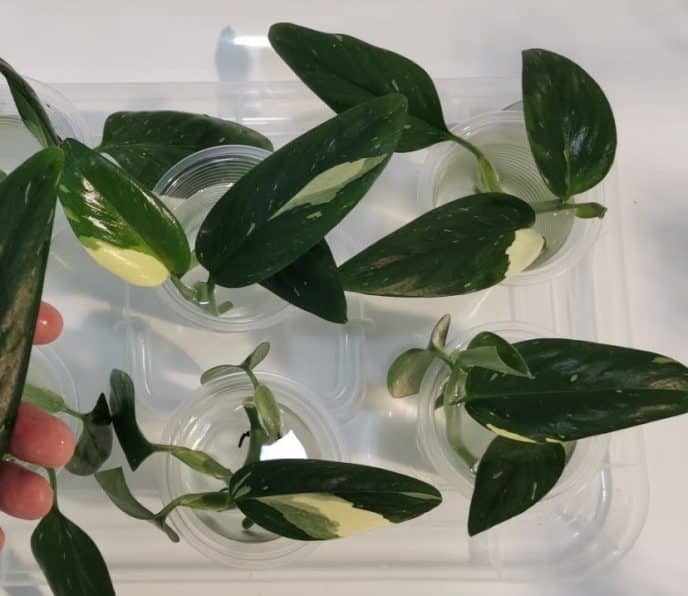
- Choose a healthy stem: Choose a healthy stem that has at least one node and one or two leaves.
- Cut the stem: Use clean, sharp scissors or pruning shears to cut the stem just below a node. Make sure the cutting is at least 4-6 inches long.
- Remove lower leaves: Remove the lower leaves from the stem, leaving only one or two leaves at the top.
- Plant the cutting: Plant the cutting in a pot filled with well-draining soil. Water the soil lightly and cover the pot with a plastic bag to create a humid environment.
- Wait for roots to develop: Keep the soil moist and place the pot in a bright, indirect light. After a few weeks, roots should start to develop from the node.
- Transplant the cutting: Once the roots are well-developed, transplant the cutting into a larger pot with well-draining soil.
Similar Plants to the Monstera Standleyana
If you love the look of Monstera Standleyana plants and want to add more plants with a similar look to your collection, here are some other plants you might consider:
Monstera Dubia
Monstera Dubia is a small and delicate plant that can grow up to a height of 3 to 5 feet. This plant has dark green leaves that are entirely solid, without any fenestrations or variegation. The leaves are heart-shaped, with slightly elongated tips, and have a velvety texture.
This plant is relatively easy to care for and can thrive in bright, indirect light. It is also known to grow well in terrariums, making it a popular choice for indoor gardening enthusiasts.
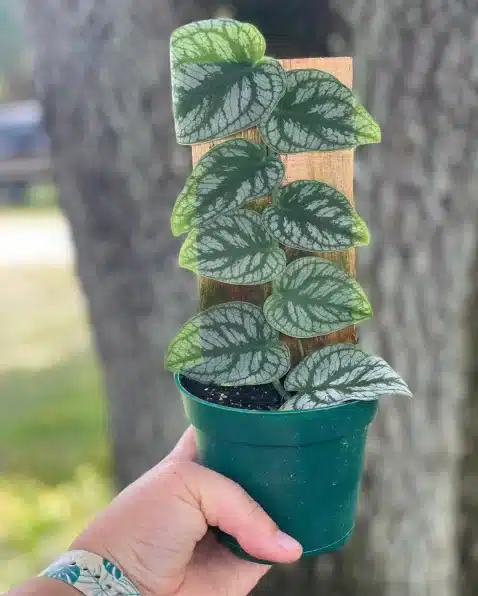
Monstera Deliciosa
Monstera Deliciosa, also known as the Swiss Cheese Plant, is a popular houseplant known for its unique and distinctive foliage. The plant features large, glossy, deep green leaves that are pinnately divided, with oval-shaped holes or fenestrations in them. Monstera Deliciosa is also popular for its air-purifying properties, making it an excellent choice for improving indoor air quality.
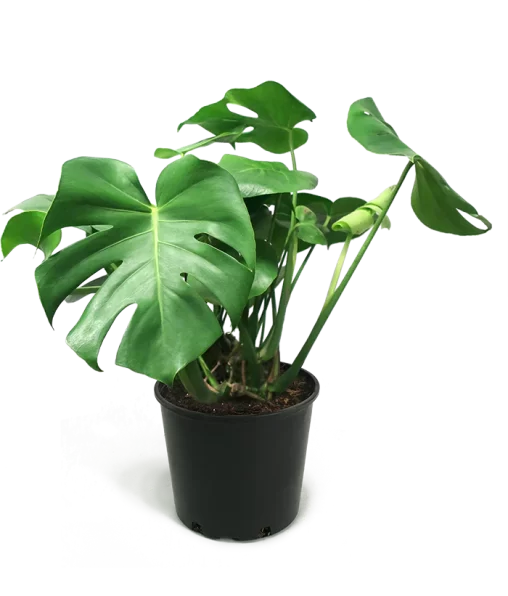
Monstera Standleyana Cobra
This is the less variegated variety of Monstera standleyana. These oblong, pointed leaves are mostly green but with some wispy flecks of white or yellow on most leaves. This variety needs slightly less light than its more variegated counterpart, so it might be a little easier to care for.
Monstera Standleyana Albo
This is the more variegated variety, which boasts much more dramatic streaks and splashes of white on top of the deep-green coloring. You might even see leaves that have more white than green.
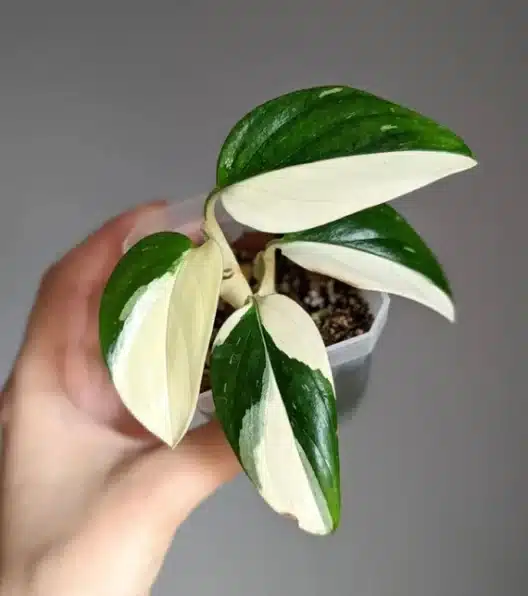
Monstera Variegata
Monstera variegata is a rare and highly sought after plant that is a variegated form of the Monstera deliciosa. It is characterized by its striking green and white variegated leaves, which can range from small flecks to large blotches of white.
Due to its popularity, Monstera variegata is quite expensive and can be difficult to find. However, it can make for a stunning addition to any plant collection.
Problems to Look for with Monstera Standleyana
While Monstera Standleyana plants are generally easy to care for, there are a few problems you may encounter. Here are some common issues to look out for:
Growing
Monstera Standleyana plants can have issues with slow growth or stunted growth if they are not getting the right amount of light or water. If the plant is not getting enough light, it may start to stretch towards the light source, leading to long, leggy stems with smaller leaves.
If the plant is getting too much light, the leaves may develop yellow or brown spots, or the edges may start to curl or burn. Overwatering or underwatering can also cause growth issues, with overwatered plants developing root rot and under-watered plants becoming wilted and droopy.
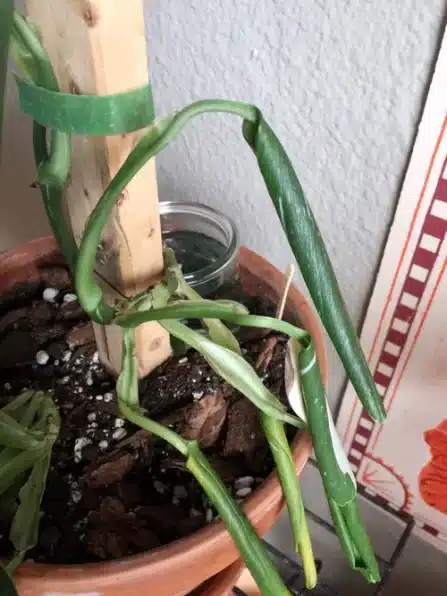
Diseases
Monstera Standleyana plants are generally quite resistant to diseases, but they can still develop issues if they are not properly cared for. Overwatering can lead to fungal diseases like root rot or leaf spot, which can cause the leaves to turn brown or yellow and fall off. Generally, issues are resulting from overwatering and poor lighting.
Pests
Monstera Standleyana plants are susceptible to a few common pests, including spider mites, mealybugs, and scale insects. These pests can be introduced to your plant through contaminated soil, water, or other plants.
Spider mites can cause yellowing leaves and webbing on the plant, while mealybugs and scale insects can cause sticky residue on the leaves and stems. If you notice any signs of pests, isolate the plant and treat it with insecticidal soap or another appropriate treatment.
Interesting Facts About the Monstera Standleyana
Monstera standleyana, commonly known as the Standleyana plant, was first discovered during an expedition to Mexico by the American naval officer and botanist, William Russell Standley, who the plant is named after.

A member of the Araceae family, this beautiful plant shares close relatives with other popular houseplants like pothos, peace lilies, and philodendrons. Although it is sometimes called Philodendron Cobra, it is not a philodendron.
FAQ’s
Is Monstera Standleyana rare?
Monstera Standleyana is a coveted addition to any plant enthusiast's collection due to its unique and striking appearance. However, it is relatively rare compared to other members of the Monstera family. More rare than some less rare than others.
Availability of this plant is more the issue you will have. While it's not as rare as other Monsteras finding a Standleyana often requires a bit of luck and stumbling upon one by chance.
How big do Monstera Standleyana get?
Monstera Standleyana plants can grow up to 5 feet tall and up to 4 feet wide in the right conditions. However, if planted outdoors a significantly different story would be told. These plants can grow up to 20 ft in the wild.
Is the Monstera standleyana toxic?
Like other Monstera plants, the Monstera Standleyana is toxic to pets and humans if ingested. Keep pets and children away.
Why is Monstera Standleyana called a five holes plant?
Monstera Standleyana is often called the “five holes plant” and there is really no reason for this designation. The fenestrations or holes allow the plant to absorb more light in its natural environment and also provide a striking visual effect that makes it a popular choice for indoor plant enthusiasts.
Unfortunately if you are a fan of the holes, this is not the plant for you, The Standleyana is more about the variegations and doesn't get the holes. It’s a mystery why it's called the five holes plant.

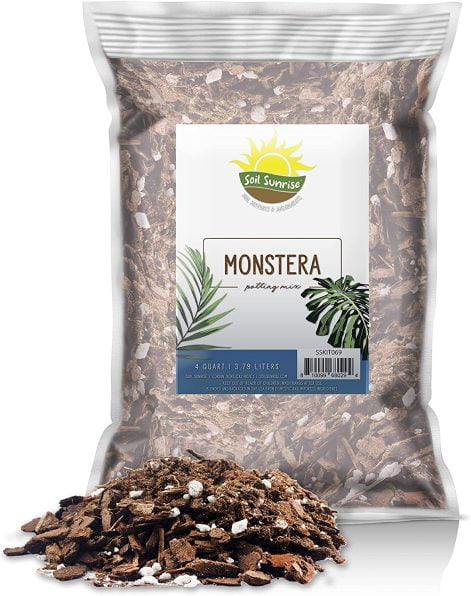


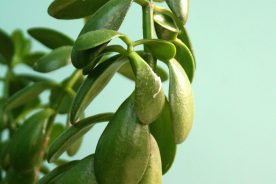

No Comments